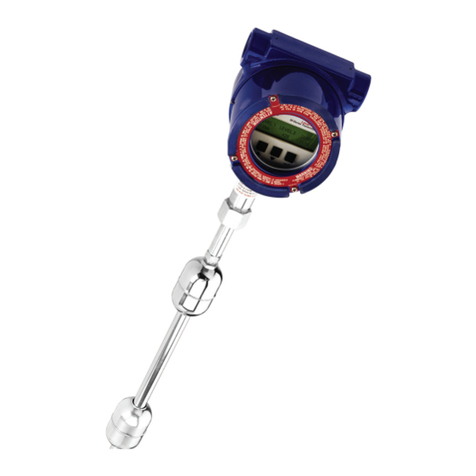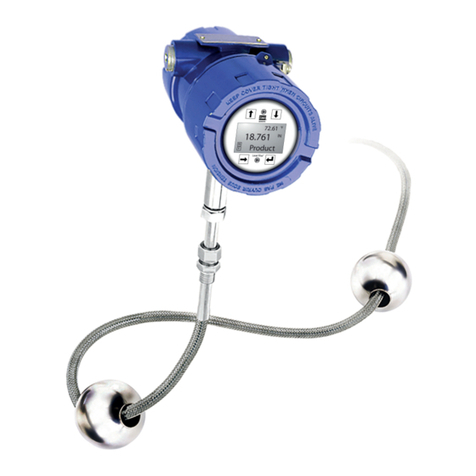
7
LP Safety Manual
LP Series
Faul Code Description Corrective Action
101 Missing
Magnet
• Verify Float Conguration is correct for
the number of oats installed
• Verify Float(s) are not in inactive zone.
• Verify Auto Threshold is enabled.
• Cycle power to sensor. If proper ope-
ration is not restored, Contact Factory
102 Internal
Fault 1
Cycle power to sensor. If proper opera-
tion is not restored, Contact Factory
103 Internal
Fault 2
Cycle power to sensor. If proper opera-
tion is not restored, Contact Factory
104 Internal
Fault 3
Cycle power to sensor. If proper opera-
tion is not restored, Contact Factory
105 Lobe Fault 1 • Verify Auto Threshold is enabled
• Cycle power to sensor
• If proper operation is not restored,
Contact Factory
106 Lobe Fault 2 • Verify Auto Threshold is enabled
• Cycle power to sensor
• If proper operation is not restored,
Contact Factory
107 Delta Fault Contact Factory to discuss application.
108 Internal
Fault 4
Cycle power to sensor. If proper opera-
tion is not restored, Contact Factory
109 Peak Fault • Verify Auto Threshold is enabled
• Cycle power to sensor
• If proper operation is not restored,
Contact Factory
110 Hardware
Fault 1
Cycle power to sensor. If proper opera-
tion is not restored, Contact Factory
111 Power Fault • Cycle power to sensor
• Verify Power Supply rating
• Verify wiring
• If proper operation is not restored,
Contact Factory
112 Hardware
Fault 2
Cycle power to sensor. If proper opera-
tion is not restored, Contact Factory
113 Hardware
Fault 3
Cycle power to sensor. If proper opera-
tion is not restored, Contact Factory
114 Hardware
Fault 4
Cycle power to sensor. If proper opera-
tion is not restored, Contact Factory
115 Timing
Fault 1
Cycle power to sensor. If proper opera-
tion is not restored, Contact Factory
116 Timing
Fault 2
Cycle power to sensor. If proper opera-
tion is not restored, Contact Factory
117 Timing
Fault 3
Cycle power to sensor. If proper opera-
tion is not restored, Contact Factory
118 DAC Fault 1 Cycle power to sensor. If proper opera-
tion is not restored, Contact Factory
119 DAC Fault 2 Cycle power to sensor. If proper opera-
tion is not restored, Contact Factory
120 DAC Fault 3 Cycle power to sensor. If proper opera-
tion is not restored, Contact Factory
121 DAC Fault 4 Cycle power to sensor. If proper opera-
tion is not restored, Contact Factory
122 SPI Fault 1 Cycle power to sensor. If proper opera-
tion is not restored, Contact Factory
123 SPI Fault 2 Cycle power to sensor. If proper opera-
tion is not restored, Contact Factory
124 Setpoint
Fault
The analog setpoints are too close.
Minimum distance is 150 mm (6 in.) for
analog and 290 mm (11.5 in.) for SIL.
Adjust programmed setpoints as nee-
ded. (Analog only) If proper operation is
not restored, Contact Factory
125 Loop 1 Out
of Range
Verify that magnets are positioned
within expected measuring range. Ad-
just programmed setpoints as needed.
(Analog only) If proper operation is not
restored, Contact Factory
126 Loop 2 Out
of Range
Verify that magnets are positioned
within expected measuring range. Ad-
just programmed setpoints as needed.
(Analog only) If proper operation is not
restored, Contact Factory
127 EEPROM
Fault 1
Cycle power to sensor. If proper opera-
tion is not restored, Contact Factory
128 EEPROM
Fault 2
Cycle power to sensor. If proper opera-
tion is not restored, Contact Factory
129 Flash Failure Cycle power to sensor. If proper opera-
tion is not restored, Contact Factory
130 Internal
Error
Cycle power to sensor. If proper opera-
tion is not restored, Contact Factory
Fig. 2: Error codes
• Calibrate
Product Level
`Current Level
`Offset
Interface Level
`Current Level
`Offset
• Factory
Settings
`Serial Number
`HW Revision
`SW Revision
Temp Setup
Float Cong
`Loop 2
Reset to Factory
8. Alarms
MTS has two separate types of alarms featuring both a software fault
alarm and a hardware fault alarm.
8.1 Software Fault Alarm
MTS offers a software fault alarm that will force the 4-20 mA output into
an either a low or high alarm state. The default setting from the factory
is a low alarm state. The low alarm state is ≤ 3.6 mA and the high alarm
state is ≥ 21.0 mA. The software fault alarm follows the recommenda-
tions by NAMUR NE 43. Typical faults that will cause a software fault
alarm are a missing float, the float in the inactive range, and the level
transmitter looking for the wrong number of floats.
8.2 Hardware Fault Alarm
MTS offers a hardware fault alarm that will force the 4-20 mA output
into a low alarm. The hardware low alarm is 3.2 mA. The hardware low
alarm is triggered when the internal diagnostics of the level transmitter
have detected a hardware issue with the 4-20 mA output.
9. Error Codes (Faults)






























